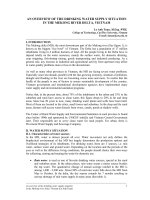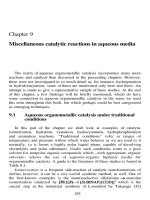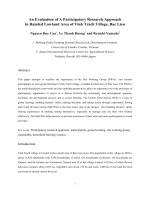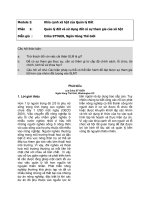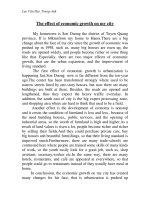Tài liệu PCR-RFLP ANALYSIS OF BETA-LACTOGLOBULIN GENE IN MURRAH BUFFALOES pdf
Bạn đang xem bản rút gọn của tài liệu. Xem và tải ngay bản đầy đủ của tài liệu tại đây (237.28 KB, 4 trang )
194
PCR-RFLP ANALYSIS OF BETA-LACTOGLOBULIN GENE
IN MURRAH BUFFALOES
S. Meignanalakshmi
1
and A.Mahalinga Nainar
2
Dept of Biotechnology, St.Peter’s Engineering College,Chennai-54,
ABSTRACT
PCR-RFLP analysis of beta-lactoglobulin gene locus was carried out on 110 DNA
samples of Murrah buffaloes in the present study. A 262 bp fragment enclosing from exon IV
to intron IV in b-lg gene was amplied with specic primers. All the 110 DNA samples resulted
in 262 bp product on amplication. The PCR products were subjected for digestion with
Pst1,EcoRI, HindIII and Hae III enzyme. PCR products were not digested by PstI, EcoRI and
HindIII. PCR products when digested with HaeIII enzyme resulted in monomorphic banding
pattern in all the samples. Sequencing of PCR products also revealed no polymorphism (
Gen Bank DQ340204 ) The DNA typing results of this study agreed completely with the milk
protein typing of same buffalo milk samples for beta-lactoglobulin by PAGE, which revealed
no polymorphism. PCR amplication and RFLP analysis presented in this study was found
to be rapid and could be used as a valuable tool to investigate polymorphism at -lg locus
directly at the DNA level without the milk samples of lactating females. One hundred and ten
DNA samples of Murrah buffaloes examined in the present study revealed no polymorphism
at b-lg gene locus.
Key words: Beta-lactoglobulin, Murrah buffalo, Polymorphism
2
Professor and Head(Retired), Dept of Animal Biotechnology, Madras Veterinary College,TANUVAS, Chennai-7
INTRODUCTION
Genetic polymorphisms are playing an
increasingly important role as genetic markers
in many fields of animal breeding. With the
development of molecular genetic techniques it
has become possible to establish a new class of
gene markers based upon the variability at DNA
sequence level. The discovery of RFLP generated
renewed interest in the use of gene marker loci as
an aid to selection programmes.
Milk protein genetic polymorphisms
have evoked considerable research interest in
recent years because of possible association
between milk protein genotypes and economically
important traits in dairy cattle. Milk protein genes
such as k-casein and b- lactoglobulin are associated
with milk production performance and have a major
inuence on the composition of milk and on the
processing properties of milk (Ng-Kwai-Hang et
al.,1990 Chung et al.,1994,Meignanalakshmi et al.,
2006).
The development of the PCR-RFLP technique to
distinguish rapidly the genotypes of b-lg at the DNA
level permits the determination of genotypes for
both sexes of animals at any age (Meignanalakshmi
et al,2001,Cengiz Elami et al., 2006).PCR-RFLP
has been used by Satyanarayana et al, 2006 for
Tamilnadu J. Veterinary & Animal Sciences 5 (5) 194-197, September - October 2009
195
genotyping beta-lactoglobulin in Sahiwal and
Tharparkar catte breeds. Milk protein genes might
be useful as genetic marker and is a promising
alternative to the current methods of trait selection
in dairy cattle breeding programmes. The work
on milk proteins in buffalo is very limited. The
objective of the present study was to amplify
the b-lg gene locus and to nd out polymorphism
at b-lg gene locus by using RFLP in Murrah
buffaloes.
MATERIALS AND METHODS
The present study was carried out on
Murrah buffaloes maintained at Central cattle
breeding farm, Alamadi, Tamilnadu. Individual
blood samples of 5 ml each were collected from
110 Murrah buffaloes using 5 ml vacuitainer tubes
containing EDTA from jugular vein and stored at
4
0
C until processed.
Genomic DNA Isolation
Blood samples collected in a vacuitainer
containing EDTA were transferred to a 15 ml
centrifuge tube and centrifuged at 4000 rpm for
10 min and plasma was discarded leaving RBCs
and WBCs. Two to three volumes of ice cold RBC
lysis buffer (0.17M NH
4
Cl) was
added and kept on
ice for complete lysis of RBCs. The leucocytes
were spun down at 4000 rpm for 15 min and the
supernatant containing lysed RBCs was discarded.
If unlysed RBCs were present, RBC lysis buffer
was added and the procedure was repeated till the
WBC pellet was devoid of unlysed RBCs. Nine
ml of TE buffer(10mM Tris HCI,0.1M EDTA,pH
8.0) was added to the WBC pellet and pellet was
resuspended by vigorous vortexing. Seventy ve
ml of proteinase K(10 mg/ml), 0.5 ml of 0.5 M
EDTA,pH 8.0 and 0.5 ml of 20% SDS were added,
mixed well and incubated at 50
0
C in a water bath
for 3h with occasional shaking.
To the digested sample, 5 ml of saturated
sodium chloride was added, vortexed and spun down
at 5000 rpm for 15 min at room temperature. The
supernatant was transferred to a sterile beaker and
two volumes of 95% ice cold ethanol was added to
the supernatant and DNA was spooled out on a glass
rod, rinsed in 70% ethanol, dried and resuspended
in 0.5 ml of TE buffer, pH 8.0 and stored at 4
0
C.
Amplication of Genomic DNA at β-lg Locus by
Polymerase chain reaction
Amplication of b-lg gene locus was carried
out by using specic primers Meignanalakshmi et
al.(2001)which amplied b-lg gene from exon IV to
intron IV (enclosing 94 base pairs of exon IV and
168 base pair of intron IV ) and resulted in 262 bp
fragment in cattle. The same primers were used for
amplifying b-lg gene in Murrah buffaloes.
The primers were obtained from Bangalore
Genei Pvt. Ltd, Bangalore. The sequence of the
forward and reverse primers are given below :
Primer I :
5’ – GTCCTTGTGCTGGACACCGACTACA-3’
Primer II:
5’ – CAGGACACCGGCTCCTGGTATATGA-3’
Reactions were carried out in 100ml volume.
The reaction conditions and reagent concentrations
were:100pmole of each primer,2.5 units of Taq.DNA
polymerase,1X PCR buffer(10mM Tris – HCL, pH
9.0, 50 mM KCL and 1.5 mM MgCl
2
), 150 mM of
each dNTP and 50 ng of genomic DNA. After an
initial denaturation of 3 min at 95
0
C, 35 cycles were
run on a Thermal Cycler (PTC 2000,MJ Research
Inc.USA) each comprising 40 sec of denaturation
at 95
o
C, 40 sec of primer annealing at 64
0
C, 30 sec
of extension at 72
0
C followed by a nal extension
for 10 min at 72
0
C . PCR products were checked
by electrophoresis on 2% Agarose gel in 1X TBE
Tamilnadu J. Veterinary & Animal Sciences 5 (5) 194-197, September - October 2009
Meignanalakshmi
and Mahalinga Nainar
196
buffer. 100bp ladder and 25bp ladder were used as
molecular weight marker.After staining the gel with
ethidium bromide, PCR products were visualized by
UV- Transilluminator and photographed.
PCR-RFLP Analysis
Fifteen ml of the amplified DNA was
digested with 20 units of EcoRI, HindIII, PstI and
Hae III at 37
0
C for 4 h. The restriction fragments
were resolved by electrophoresis in 4% Agarose
gel in 1X TBE buffer. 100 bp ladder was used as
molecular weight marker. After staining the gel
with ethidium bromide, fragments were visualized
by UV transilluminator and photographed. All the
PCR products were puried by using Qiagen PCR
product purication columns and were sequenced
in Genei.
RESULTS AND DISCUSSION
Primers used for cattle (Meignanalakshmi
et al., 2001) were found to be suitable for amplifying
b-lg gene in Murrah buffaloes ,which resulted in 262
bp fragment (Fig.1). Kim et al.,(1997) also reported
that the amplied product with these primers was
262 bp in Hanwoo cattle. In the present study, all the
110 DNA samples of Murrah buffaloes gave the ex-
pected 262 bp fragment on amplication without any
non specic DNA amplication. The PCR products
were not digested by PstI, EcoRI and Hind III. The
PCR product (262 bp fragment) of b-lg gene when
digested with Hae III enzyme resulted in mono-
morphic banding pattern in Murrah buffaloes.All
the PCR products(110 samples) on digestion with
Hae III resulted in the same monomorphic banding
pattern. (Fig.2). No polymorphism was found to be
present in the b-lg gene locus of Murrah buffaloes
in the present study. PCR product was sequenced
(Sequence has been submitted to GenBank and have
been assigned the accession number (DQ340204 )
PCR amplication and RFLP analysis of b-lg locus
of 110 Murrah buffaloes revealed no polymorphism
in the present study. The DNA typing results of this
study agreed completely with the milk protein typ-
ing of same buffalo milk samples, which revealed
the monomorphic banding pattern on PAGE (Meig-
nanalakshmi and Mahalinganainar, 2007). This
PCR-RFLP study can be used as a valuable tool to
identify polymorphism at b-lg locus at any age of
the animal irrespective of sex and eliminates the
need for the milk of lactating females.
Tamilnadu J. Veterinary & Animal Sciences 5 (5) 194-197, September - October 2009
PCR-RFLP analysis of
Fig.1.
Agarose gel electrophoresis of PCR products of
beta-lactoglobulin gene in Murrah buffaloes.
Lane 1,2,3,4 and 5 : 262 bp PCR product of
β-lg gene of Murrah buffaloes
Lane 6: Molecular Size marker - 100 bp ladder
197
REFERENCES
Cengiz Elmaci,Yasemin Oner
and. Soner Balcioglu.2006. Genetic
Polymorphism of â- Lactoglobulin
Gene in Native Turkish Sheep breeds.
Biochemical Genetics. 44: 376-381.
Chung, E. R., Kim, W.T. and Han,S.K. (1994).
DNA genotyping of beta-lactoglobulin
locus PCR-RFLP as a selection aid for
genetic improvement of dairy cattle.
Korean J. Anim. Sci. 36: 606-612.
Kim, J. H., Shin, H.D.D., Han, S. W., Sang, B.C.
and Won, Y.S. (1997). Polymorphisms of
kappa-casein and beta-lactoglobulin genes
using the polymerase chain reaction in
Hanwoo(Korean native) cattle. Korean J.
Anim. Sci. 39 : 481-488.
Meignanalakshmi.S and Mahalinga Nainar
2007. Electrophoretic pattern of beta-
lactoglobulin in buffalo milk. Tamil
Nadu Journal of Veterinary and Animal
Sciences, 3:150-155
Meignanalakshmi,A., Mahalinga Nainar,A and
Nachimuthu,K. (2001). Identification
of genetic polymorphism of beta-
lactoglobulin gene locus in Red Sindhi
cows by PCR-RFLP Analysis.
Inter.J.Anim.Sci. 16 : 223-226
Meignanalakshmi,A., Mahalinga Nainar,A,
Thiagarajan,V and Nachimuthu,K.2006.
Effect of genetic variants of beta-
lactoglobulin on milk production traits
in Red Sindhi cows. Indian Journal of
Animal Sciences., 76:934-936.
Ng-Kwai-Hang,K.F., Monardes,H.F. and Haynes,
J.F. (1990). Association between genetic
polymorphism of milk proteins and
production traits during three lactations.
J. Dairy Sci. 73 : 3414-3420.
Satyanarayana Rachagani,Ishwar Dayal
Gupta,Neelam Gupta,and Gupta.(2006)
Genotyping of â-Lactoglobulin gene by
PCR-RFLP in Sahiwal and Tharparkar
cattle breeds. BMC Genetics, 7:31
Tamilnadu J. Veterinary & Animal Sciences 5 (5) 194-197, September - October 2009
Meignanalakshmi
and Mahalinga Nainar
Fig 2.
Agarose gel electrophoresis of HaeIII digested
PCR products of beta-lactoglobulin gene in
Murrah buffaloes.
Lane 1, 2 ,3 and 4 : Hae III digested PCR products of -lg gene
in Murrah Buffaloes
Lane 5: Molecular size marker - 100 bp adder.
Lane 6: Molecular size marker- 25 bp ladder


